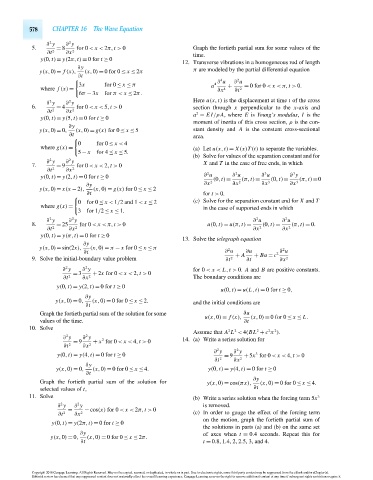Page 598 - Advanced_Engineering_Mathematics o'neil
P. 598
578 CHAPTER 16 The Wave Equation
2
2
∂ y ∂ y
5. = 8 for 0 < x < 2π,t > 0 Graph the fortieth partial sum for some values of the
∂t 2 ∂x 2 time.
y(0,t)= y(2π,t) = 0for t ≥ 0
12. Transverse vibrations in a homogeneous rod of length
∂y
y(x,0)= f (x), (x,0) = 0for0 ≤ x ≤ 2π π are modeled by the partial differential equation
∂t
∂ u ∂ u
4 2
3x for 0 ≤ x ≤ π a 4 + = 0for0 < x <π,t > 0.
where f (x) = ∂x 4 ∂t 2
6π − 3x for π< x ≤ 2π.
2
2
∂ y ∂ y Here u(x,t) is the displacement at time t of the cross
6. = 4 for 0 < x < 5,t > 0 section through x perpendicular to the x-axis and
∂t 2 ∂x 2
2
a = EI/ρ A,where E is Young’s modulus, I is the
y(0,t)= y(5,t) = 0for t ≥ 0
moment of inertia of this cross section, ρ is the con-
∂y
y(x,0)= 0, (x,0) = g(x) for 0 ≤ x ≤ 5 stant density and A is the constant cross-sectional
∂t area.
0 for 0 ≤ x < 4
where g(x) = (a) Let u(x,t) = X(x)T (t) to separate the variables.
5 − x for 4 ≤ x ≤ 5.
(b) Solve for values of the separation constant and for
2
2
∂ y ∂ y
7. = 9 for 0 < x < 2,t > 0 X and T in the case of free ends, in which
∂t 2 ∂x 2
3
2
3
2
y(0,t)= y(2,t) = 0for t ≥ 0 ∂ u ∂ u ∂ u ∂ y
(0,t)= (π,t)= (0,t)= (π,t)=0
∂y ∂x 2 ∂x 2 ∂x 3 ∂x 3
y(x,0)= x(x − 2), (x,0) = g(x) for 0 ≤ x ≤ 2
∂t for t > 0.
0 for 0 ≤ x < 1/2and 1 < x ≤ 2 (c) Solve for the separation constant and for X and T
where g(x) = in the case of supported ends in which
3 for 1/2 ≤ x ≤ 1.
2
2
2
2
∂ y ∂ y ∂ u ∂ u
8. = 25 for 0 < x <π,t > 0 u(0,t) = u(π,t) = (0,t) = (π,t) = 0.
∂t 2 ∂x 2 ∂x 2 ∂x 2
y(0,t)= y(π,t) = 0for t ≥ 0
13. Solve the telegraph equation
∂y
y(x,0)= sin(2x), (x,0) = π − x for 0 ≤ x ≤ π 2 2
∂t ∂ u + A ∂u + Bu = c 2 ∂ u
9. Solve the initial-boundary value problem ∂t 2 ∂t ∂x 2
2
2
∂ y ∂ y for 0 < x < L,t > 0. A and B are positive constants.
= 3 + 2x for 0 < x < 2,t > 0
∂t 2 ∂x 2 The boundary conditions are
y(0,t) = y(2,t) = 0for t ≥ 0
u(0,t) = u(L,t) = 0for t ≥ 0,
∂y
y(x,0) = 0, (x,0) = 0for0 ≤ x ≤ 2. and the initial conditions are
∂t
Graph the fortieth partial sum of the solution for some ∂u
u(x,0) = f (x), (x,0) = 0for0 ≤ x ≤ L.
values of the time. ∂t
10. Solve
2
2
2
2
2
Assume that A L < 4(BL + c π ).
2
2
∂ y ∂ y 14. (a) Write a series solution for
2
= 9 + x for 0 < x < 4,t > 0
∂t 2 ∂x 2
2
2
∂ y ∂ y
3
y(0,t) = y(4,t) = 0for t ≥ 0 = 9 + 5x for 0 < x < 4,t > 0
∂t 2 ∂x 2
∂y
y(x,0) = 0, (x,0) = 0for0 ≤ x ≤ 4. y(0,t) = y(4,t) = 0for t ≥ 0
∂t
∂y
Graph the fortieth partial sum of the solution for y(x,0) = cos(πx), (x,0) = 0for 0 ≤ x ≤ 4.
selected values of t, ∂t
11. Solve (b) Write a series solution when the forcing term 5x 3
2
2
∂ y ∂ y is removed.
= − cos(x) for 0 < x < 2π,t > 0
∂t 2 ∂x 2 (c) In order to gauge the effect of the forcing term
on the motion, graph the fortieth partial sum of
y(0,t) = y(2π,t) = 0for t ≥ 0
the solutions in parts (a) and (b) on the same set
∂y of axes when t = 0.4 seconds. Repeat this for
y(x,0) = 0, (x,0) = 0for 0 ≤ x ≤ 2π.
∂t t = 0.8,1.4, 2,2.5, 3, and 4.
Copyright 2010 Cengage Learning. All Rights Reserved. May not be copied, scanned, or duplicated, in whole or in part. Due to electronic rights, some third party content may be suppressed from the eBook and/or eChapter(s).
Editorial review has deemed that any suppressed content does not materially affect the overall learning experience. Cengage Learning reserves the right to remove additional content at any time if subsequent rights restrictions require it.
October 14, 2010 15:23 THM/NEIL Page-578 27410_16_ch16_p563-610

